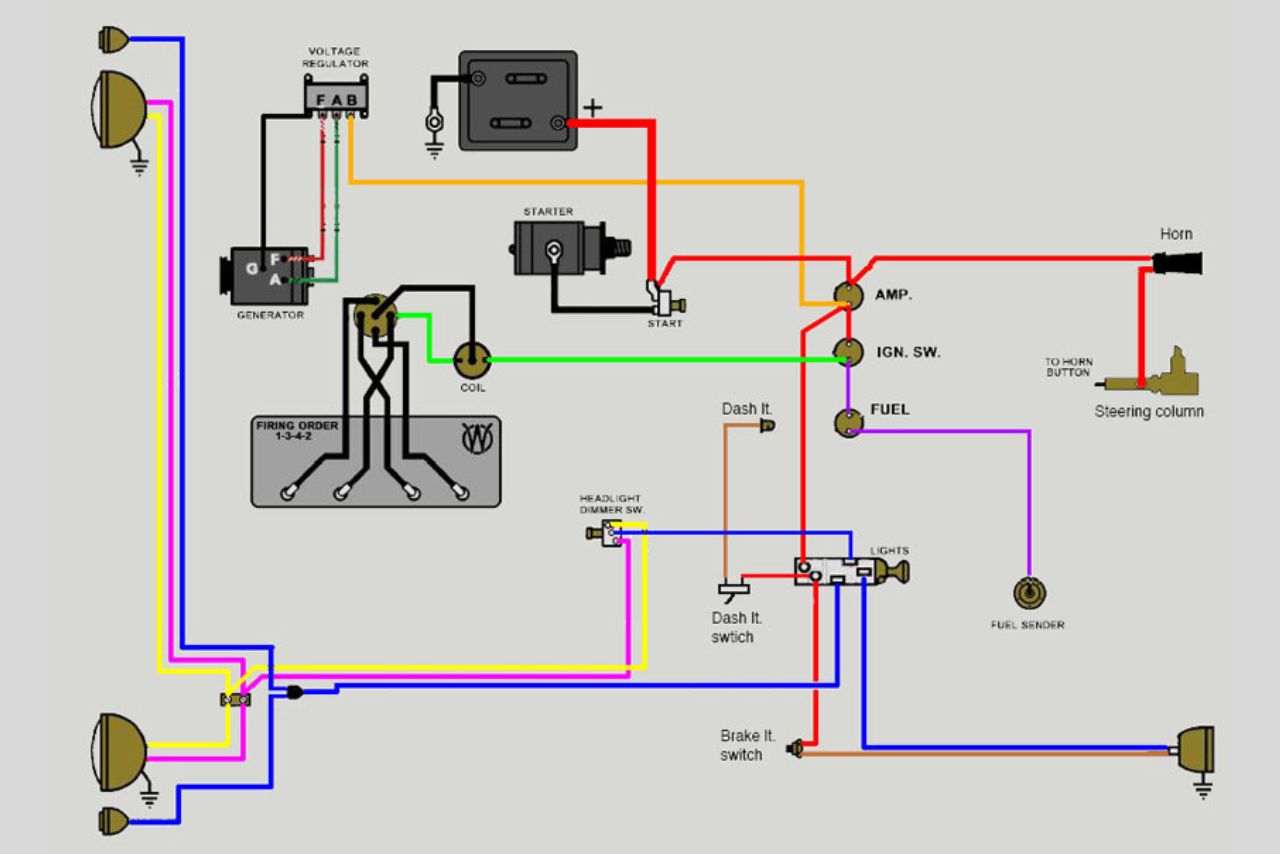A 12V ignition switch wiring diagram is a useful tool for understanding how the electrical components in your vehicle’s ignition system are connected.
If you’ve ever wondered about the intricacies of this crucial part, you’re in the right place.
In this article, we will provide a simple and concise explanation of what a 12V ignition switch wiring diagram is and how it can help you troubleshoot any issues with your vehicle’s ignition system.
So, let’s dive in and unravel the mysteries behind this essential automotive component!
Table of contents
What Is a 12v Ignition Switch?
A 12V ignition switch is a switch that controls the flow of electricity to the ignition system of a vehicle. It is typically located on the steering column and has three or four positions:
Some ignition switches also have a fourth position, which is used for accessories such as a remote starter or alarm system.
The ignition switch is typically actuated by a key, but some vehicles have push-button ignition switches. The switch is made of a metal alloy and has several terminals that connect to the different wires in the ignition system.
When the ignition switch is turned to the ON position, it closes a circuit that allows power to flow from the battery to the ignition system. This power is then used to energize the ignition coil, which creates a spark that ignites the fuel in the engine.
Here Are Some of The Common Problems with A 12 v Ignition Switch:
If you experience any problems with your ignition switch, it is important to have it repaired or replaced by a qualified mechanic.
How Does A 12v Ignition Switch Work?
A 12V ignition switch works by turning a mechanical rotary switch that connects and disconnects electrical circuits in the vehicle’s ignition system. The switch is typically located on the steering column and is operated by a key.
When the key is turned to the ON position, the switch closes a circuit that allows power to flow from the battery to the ignition coil. The ignition coil then uses this power to create a spark that ignites the fuel in the engine.
The ignition switch also has a START position. When the key is turned to this position, the switch engages the starter motor, which cranks the engine.
The ignition switch is an important part of the vehicle’s ignition system and is essential for starting the engine. If the ignition switch fails, the engine will not start.
Here Is a More Detailed Explanation of How a 12 v Ignition Switch Works:
12v Ignition Switch Wiring Diagram:

When the key is turned to the ACC position, the switch closes the circuit between the ACC terminal and the BAT terminal. This allows power to flow from the battery to the accessories.
When the key is turned to the ON position, the switch closes the circuit between the ON terminal and the BAT terminal. This allows power to flow from the battery to the ignition system.
When the key is turned to the START position, the switch closes the circuit between the START terminal and the BAT terminal. This engages the starter motor, which cranks the engine.
Once the engine starts, the key should be turned back to the ON position. This will prevent the starter motor from running continuously and damaging itself.
The Basics of Ignition Switch Wiring:

When it comes to understanding ignition switch wiring, it’s essential to grasp the basics. The ignition switch plays a crucial role in starting and powering your vehicle.
It acts as a control device that allows or interrupts the flow of electrical current from the battery to various components.
To help you understand how ignition switch wiring works, let’s break down its key elements:
It is important to note that every vehicle may have slight variations in their ignition switch wiring depending on make and model specifications.
How to Wire a 12v Ignition Switch?

Here is the step by step guide to wire a 12v Ignition Switch.
When it comes to wiring an ignition switch, having the right tools and materials at hand can make the process much smoother. Here are some essential items you’ll need:
Tools:
Materials:
Step-by-Step Guide: How to Wire a 12v Ignition Switch?

| Terminal | Description |
|---|---|
| B+ | Battery positive connection |
| ACC | Accessory power connection |
| IGN | Ignition power connection |
| ST/STA | Starter motor solenoid connection |
Common Mistakes to Avoid When Wiring an Ignition Switch:
When it comes to wiring an ignition switch for your 12v system, there are a few common mistakes that you should avoid. These mistakes can lead to electrical issues or even pose a safety risk.
To ensure a smooth and trouble-free installation, keep the following points in mind:
Troubleshooting Tips for Issues with Ignition Switch Wiring:
Here are some troubleshooting tips to help you identify and resolve issues with your 12v ignition switch wiring:
Conclusion: 12v Ignition Switch Wiring Diagram!
Understanding the 12v ignition switch wiring diagram is essential for anyone working with automotive electrical systems.
By following the correct wiring connections and ensuring proper grounding, you can ensure a smooth and reliable ignition process for your vehicle.
Remember to always refer to the specific wiring diagram provided by your vehicle’s manufacturer or consult an expert if you encounter any difficulties during installation or troubleshooting.
Taking the time to familiarize yourself with the different components and their functions will save you time, effort, and potential costly repairs in the long run.
With this knowledge at hand, you’ll be better equipped to tackle any issues related to your vehicle’s ignition system confidently.
Whether it’s replacing a faulty switch or installing a new one, having a clear understanding of the 12v ignition switch wiring diagram empowers you to maintain optimal performance and functionality of your vehicle’s electrical system.
FAQs
Why Do I Need a 12v Ignition Switch Wiring Diagram?
A 12v ignition switch wiring diagram is necessary when you need to understand or troubleshoot the electrical system of a vehicle.
It helps you to identify the correct wires and connections for the ignition switch, which is essential for starting the engine and controlling various electrical functions in the vehicle.
How to Read a 12v Ignition Switch Wiring Diagram?
To read a 12v ignition switch wiring diagram, you should start by identifying the various symbols and labels used in the diagram.
These symbols represent different components such as batteries, fuses, switches, and wires.
Each component is usually labeled with a letter or number that corresponds to a specific terminal or connection point.
What Are the Common Components in A 12v Ignition Switch Wiring Diagram?
Common components in a 12v ignition switch wiring diagram include the ignition switch itself, starter motor, ignition coil, battery, fuse box, and various accessories such as lights, radio, and air conditioning.
Can I Modify the 12v Ignition Switch Wiring Diagram?
It is generally not recommended to modify the wiring diagram of a vehicle’s electrical system unless you have a good understanding of electrical circuits and automotive wiring.
Modifying the wiring without proper knowledge can lead to electrical problems, short circuits, and other issues.
Where Can I Find a 12v Ignition Switch Wiring Diagram for My Vehicle?
You can find a 12v ignition switch wiring diagram for your specific vehicle in the service manual or repair manual for that vehicle.
These manuals are available from automotive stores, online retailers, or directly from the vehicle manufacturer.
Latest Posts:
- Benelli TNT 135 vs Grom! (A Proper Review!)
- What Problems Does The Kymco Ak 550 Have? Find Solution!
- Jetson Bolt Pro Troubleshooting! (The Ultimate Guide!)
- Top 10 Best Electric Scooters For Kids (Tried And Tested!)
- 10 Best 150cc Bike For Beginners: (Tried And Tested!)
- What Does 16 Mean To The Pagans? (The Surprising Truth!)
















